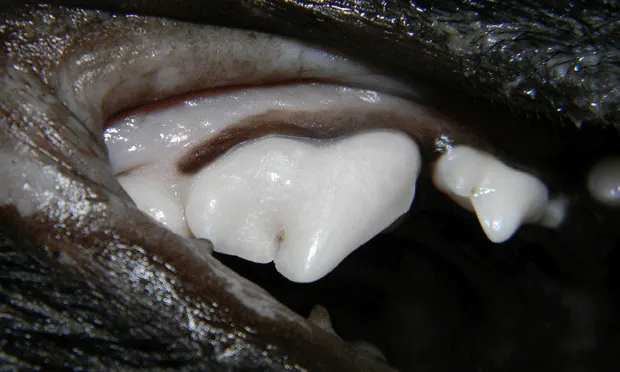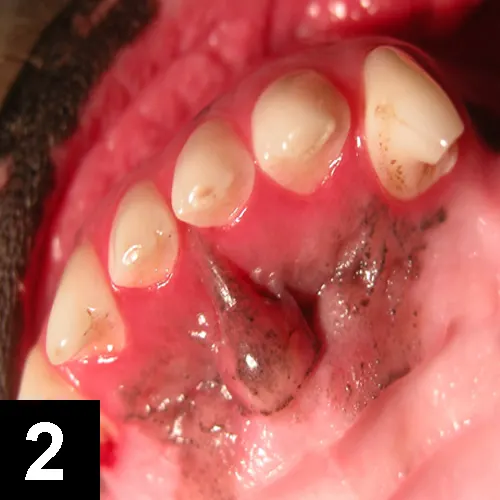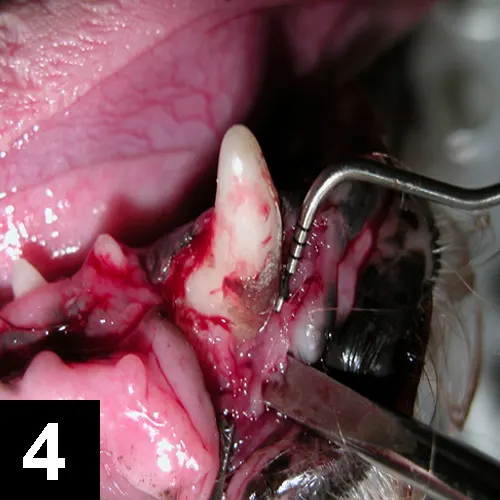Point/Counterpoint: Is Dental Cleaning Possible Without Anesthesia?

Point/Counterpoint is an online opinion/editorial forum to discuss controversial issues in veterinary medicine. As such, the content is not subject to the peer review process.
Nonanesthetic Dentistry: Words of Caution
Brook A. Niemiec, DVM, DAVDC, FAVD
Proponents of nonanesthetic dentistry (NAD), also called anesthesia-free dentistry, exploit unfounded fears regarding general anesthesia, promoting NAD as an economic alternative to traditional procedures.
Related Article: Anesthesia Monitoring: Raising the Standards of Care
In reality, NAD procedures are not only ineffective, but also potentially dangerous and as expensive (if not more so) than properly performed cleanings under anesthesia. With NAD, teeth are scaled by nonprofessionals in a conscious patient. Some practitioners and/or companies may tout a “training course” or “certificate” in their “proprietary” technique, but these types of courses offer just a few hours to days of insufficient training. With unskilled operators working on awake (moving) patients, scaled teeth are often left with roughened surfaces (Figure 1, above). Combined with the lack of polishing, these factors lead to much faster disease recurrence.<sup1, 2, 3sup>
A complete dental prophylaxis or cleaning is an involved process.<sup4, 5, 6sup> The detailed steps may vary depending on the practitioner, but achieving a positive medical benefit should minimally include supra- and subgingival scaling (ie, cleaning above and below the gum line), polishing, sulcal lavage, oral examination (including periodontal probing), and charting.<sup7, 8, 9, 10sup> Additionally, dental radiographs are a critical aid to proper dental care and cannot be acquired without anesthesia.<sup11, 12, 13, 14, 15sup>
Related Article: Digital Dental Radiology
Of the required steps for an effective cleaning, only the first step (supragingival scaling) can be partially performed without anesthesia. Furthermore, even this step is poorly performed in nonanesthetized patients, especially on the lingual/palatal surfaces and in the back of the mouth

(Figure 2). Moreover, the single most important step of a prophylaxis (subgingival plaque and calculus removal) cannot be done properly without general anesthesia.<sup16, 17sup>
Patients are often seen following NAD with clean crowns but significant areas of subgingival calculus.

(Figure 3). This is likely the biggest problem with NAD service, as it gives a false sense of improved dental health for pets. Numerous clients are upset when dental disease is diagnosed despite repeated investment in NAD and the appearance of “clean” crowns in their pet’s mouth. These clients feel that they have failed their pet, allowing them to progress to significant disease despite well intentioned efforts. Many of these patients present for severe halitosis, but some may present after the NAD practitioner has manually extracted several teeth. This author repeatedly treats regular NAD patients needing multiple extractions to resolve severe dental disease who received NAD as recently as 2 weeks prior, including one patient who required extractions at 38 teeth which were “cleaned” within 21 days of presentation.
A tooth-by-tooth oral examination with periodontal probing is another critical step of a proper dental cleaning.<sup18, 19, 20sup> Oral disease often has subtle clinical signs, even in cases of significant infection (Figures 4 and 5). Without anesthesia, a complete oral examination is impossible.<sup21, 22sup> Finally, even when a limited examination is performed by NAD practitioners, they are essentially diagnosing dental disease. This is, by any standard, practicing medicine without a license.
Proponents of NAD tout it as being safer than general anesthesia, but this is not true. This procedure carries a high risk for iatrogenic damage. The sharp instruments required for a proper cleaning can lacerate delicate gingival tissues if the patient moves, which is repeatedly seen and reported. Jaw fractures and neck injuries have been seen following restraint for NAD, and the risk for aspiration pneumonia from the lack of intubation is of high concern.
In contrast, well-performed general anesthesia is very safe. When current standards of multimodal anesthesia are performed with appropriate monitoring, rarely are there complications. One study suggested that mortality risk in healthy dogs was 0.05%.23 Since these practices had widely varying anesthetic protocols and monitoring, ideal anesthesia protocols and monitoring should improve this number even further.24
Based on the numerous limitations and dangers of NAD, the American Veterinary Dental College has drafted a position statement against this procedure. In addition, NAD may be illegal in many states unless performed under the supervision of a veterinarian. Some NAD providers work around these laws by performing the service in veterinary hospitals, which, while legal, is considered well below the standard of practice.
View the statement from the American Veterinary Dental College)
It should also be noted that in these cases, it is the prescribing (ie, practice owner) veterinarian’s license at risk, not the contracted service provider. Therefore, think carefully before allowing this procedure in your practice.
The issue of cost is also a proposed benefit of NAD over traditional anesthetized cleanings. However, under closer examination, it is generally more expensive than traditional cleaning. In southern California, the initial NAD procedure can run from $75–$125, with monthly maintenance of $35–$65. This means that the first year can amount to $460–$840. In contrast, an annual cleaning in a general practice is typically $400–$600 and, in this author’s specialty practice averages at $700 before radiographs.
The best way to challenge this dangerous and nonbeneficial practice is client education.25 In the minds of most clients (and some veterinarians), this service seems like an excellent alternative to general anesthesia, reinforced the visibly clean areas of the mouth following a NAD procedure. However, disease lurks under the gum line regardless of how clean the crowns appear to be, and veterinary dentists have scores of cases demonstrating the ineffectiveness and dangers of NAD.
The bottom line? NAD provides no medical benefit. In reality, current anesthesia and monitoring techniques make dental anesthetic procedures very safe, and superior equipment and training have markedly improved the quality of professional dental cleanings.
Dr. Brook Niemiec is a 1994 graduate of the University of California, Davis School of Veterinary Medicine. He is a Board Certified Specialist in Veterinary Dentistry as well as a Fellow in the Academy of Veterinary Dentistry and past member of the board of directors and President Elect of the Academy of Veterinary Dentistry.
Professional Outpatient Preventive Dentistry as Adjunctive Therapy
Stephanie Sur, DVM
Professional Outpatient Preventive Dentistry (POPD), a term developed by Pet Dental Services, uses a thorough visual periodontal examination to perform dental prophylaxis on cats and dogs without general anesthesia; behavioral management and minimal physical restraint are used during the procedure. The term non-professional dental scaling (NPDS) has been typically used to describe sub-standard dental practices performed by nonprofessionals in nonveterinary facilities. The National Pet Dental Association was developed to increase awareness about the differences between both procedures and dangers associated with medical procedures without veterinary supervision.
Unlike NPDS, POPD is performed with the direct supervision of a veterinarian and includes periodontal probing, supragingival scaling, subgingival curettage, machine polishing, and irrigation of all surfaces. Veterinarians individually select patients as appropriate candidates for POPD. Any significant abnormalities or advanced pathology detected during preliminary examination discontinues candidacy for POPD.
Careful measures and steps ensure operator and patient safety throughout the procedure, including use of piezoelectric scalers to avoid soft tissue damage secondary to potential patient movement during the procedure. Patients are conscious and fully awake; complete control over the gag reflex is employed to reduce risk for aspiration. Behavioral management and prescreening significantly reduce potential for adverse reactions.
As a result of these cautious measures, the debate surrounding nonanesthetic dentistry may not be a result of problems associated with the lack of anesthesia, but rather untrained individuals without veterinary supervision.
When performed correctly and prescribed appropriately by veterinarians, POPD can be extremely valuable. It is not intended to replace anesthetized dentistry; rather, it serves as adjunctive therapy to anesthetic dental procedures. Compliance and prevention of dental disease are increased with more frequent routine cleanings and oral examinations.
Veterinarians must confirm whether the service is indicated, acknowledging that general anesthesia is required for exposing dental radiographs. Veterinarians with access to radiographs may recommend annual anesthetic dental procedures in addition to annual POPDs, allowing patients biannual dental prophylaxis and periodontal evaluations.
In general, POPD is best used as a preventive service for young pets, as maintenance therapy in the interim between anesthetic dentals for pets with a high predisposition for periodontitis or high-risk patients unable to safely undergo anesthesia. POPD can be an adjunctive therapy for a veterinary dental program, providing another avenue of periodontal therapy for the veterinarian to use at his/her discretion.
STEPHANIE SUR, DVM, practices small animal medicine and acupuncture in Almaden Valley, California. Dr. Sur is a member of the AVMA, CVMA, AAVA, AHVMA, and HSVMA. Dr. Sur earned her DVM at Ross University. Dr. Sur is also member of the Board of Directors for the National Pet Dental Association and works with Pet Dental Services, a company that provides anesthesia-free dental care to cats and dogs under the supervision of licensed veterinarians.